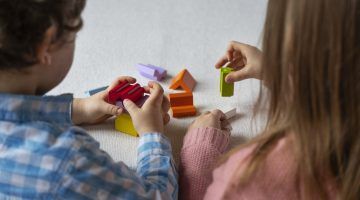30 Basic Classroom Rules For Kids
Updated on April 22, 2024
Picture this: you’re in the middle of explaining trigonometry, working hard to keep everyone engaged, when suddenly, Casey decides to break Mason’s ruler. Chaos ensues, and before you know it, your entire class is fixated on this mini-drama, forgetting all about trigonometry.
This is just one example, but let’s be honest; there are plenty more where that came from. Kids are easily distracted, and without some ground rules, maintaining focus in the classroom can feel like herding cats. That’s where classroom rules come in.
Importance of Classroom Rules
Having clear, effective rules for classroom is like setting the boundaries of a game. They provide a structure that kids can understand and follow, creating a conducive environment for learning. Think of these rules as the glue that holds your class together. They help maintain discipline and ensure unexpected conflicts or disruptions don’t constantly derail your teaching.
Imagine if there were no class rules. Every day would be a potential minefield of distractions, making it nearly impossible to get through a lesson without interruptions. Establishing and enforcing classroom rules creates a stable and predictable atmosphere. This stability allows you to focus on teaching, confident that everyone in the room is on the same page. Here is a list of reasons why you need classroom rules for students:
Setting clear expectations
When you set rules in your class, you establish clear expectations. This helps students know what you expect from them and what they can expect from you. It also fosters respect and sets boundaries, preventing chaos and disruptions. Classroom rules and expectations work hand-in-hand, and they tell students that breaking the rules has consequences that affect the whole class.
Structuring the Class Environment
Creating a structured schedule as part of the rules of the classroom is crucial for effective teaching and learning. When you establish clear timeframes for learning activities, both you and your students benefit. Students understand when they are expected to focus on learning, eliminating distraction. By setting these time boundaries, you provide a framework that helps everyone manage their time effectively. It ensures that learning takes priority during designated hours. This structure also ensures that students are punctual to class and that lateness attracts consequences.
Reducing Behavioral Issues
As children grow, they might act out due to various influences. A teacher’s role is akin to being a guide in a park, helping children navigate these challenges. It’s crucial for kids to learn that disruptive behavior isn’t acceptable; throwing tantrums or distracting the class makes it hard for everyone to concentrate. These behavioral issues can’t be ignored. The rules and procedures in the classroom should teach the kids that their behavior can attract consequences.
Boosting Learning Productivity
When students have clear expectations, they can concentrate better in class and are less likely to get distracted. Understanding what is expected of them leads to increased focus, better comprehension of the lessons, and enhanced productivity. The rules and expectations in the classroom set the stage for an environment where each student can concentrate on their learning and grasp the concepts being taught by the teacher.
30 Comprehensive Classroom Rules for Different Age Groups
Each class has its own classroom rules designed specifically for them. The reason for this is that each grade has different ages of students. classroom rules for preschool differ from classroom rules for middle school. Of course, there are generic rules that apply to all classes, but mostly, there are specific rules for each level that the kids get to. So here are 30 best classroom rules for kids divided into different sections.
Generic classroom rules
Here are some general classroom rules that apply to everyone
- Come to class on time.
- Raise your hands before speaking.
- Keep your hands to yourself, and do not touch another person unless consent has been established.
- Do not take something that doesn’t belong to you.
- Do not raise your voice at teachers or students.
- Do not cheat during examination.
- Turn in all your assignments on time, and if there is a reason you cannot, let the teacher know on time.
- Keep your language clean.
- Unless asked, keep your personal beliefs and religion out of the classroom.
Here are some of the rules attached to different learning levels:
Preschool Classroom Rules
When creating classroom rules for kindergarten, you have to create them in a language that they understand, so here are some pre-kindergarten classroom rules that you can use for your preschoolers:
- We use only our inside voice when talking
- We do not call our classmates bad names.
- We do not throw our things.
- We do not spit at our classmates or our teachers.
- We do not destroy things belonging to our classmates.
Elementary classroom rules
Elementary school is a step up from preschool, and as such, the language has to change again to suit the class you are teaching. Here are some simple classroom rules for elementary school kids.
- Always show respect to others.
- Pay attention when the teacher is talking.
- Don’t hesitate to seek help when you need it.
- Come prepared with the necessary items every day.
- Follow instructions and listen attentively.
- Raise your hand before speaking or leaving your seat.
Middle School Classroom Rules
As stated earlier, the tone will again change to suit the learning system of middle school students. here are some of these middle school classroom rules:
- Complete and submit assignments on time
- Keep your classroom and school environment clean and tidy.
- Handle disagreements respectfully.
- Respect others’ personal space and belongings.
- Take ownership of your actions.
High School Classroom Rules
When kids get to high school, you would expect them to be more mature, and not need so much rules for the classroom because everyone should know what they need to do at certain times. However, you would be surprised to learn that you need even more stringent good classroom rules. Here are some of these highschool classroom rules.
- Resolve conflicts peacefully. Seek help from a teacher or counselor if needed.
- Respect the privacy of your peers and teachers. Do not share personal information without permission.
- Use the internet responsibly, following guidelines set by the school and the teacher.
- Adhere to the school’s dress code policy. Dress appropriately and professionally for the learning environment.
- Use electronic devices responsibly and only for educational purposes, following the teacher’s guidelines.
Crafting the Perfect Set of Rules
Crafting the perfect set of rules isn’t something that’s easy to do. You want to come off as assertive because kids can be quite challenging. However, you don’t want to come off as a bully, so you have to find a balance. So, here are a few tips that you can work with if you’re trying to craft the perfect set of positive classroom rules for your kids.
Balancing Strictness and Flexibility
This might be hard to believe, but there is such a thing as being too strict when setting classroom rules. If you already have kids with behavioral issues, you know that imposing strict rules and making subtle threats will do nothing. For some of these kids, they have faced consequences repeatedly, making it no deterrent.
If you’re working with kids from middle school downwards, there are certain students who are no longer afraid of being sent to the naughty corner or facing the wall. Similarly, with older students in high school, you’ll realize that tension in the classroom is something they find amusing.
On the other hand, you also cannot be too flexible and let anything go in your class. When kids are entrusted into your care as a teacher, your responsibility doesn’t just involve teaching; you also have to mold them into decent human beings for society. One way to do this is to strike a balance between strict rules and flexibility.
Using Positive Language in Rules
When you are laying out your rules in the classroom for your students, you must ensure that you are using positive language when giving out these rules. You are not just a teacher; you are an example to them. So, if you’re giving rules about how they should speak to each other and you’re using negative language, it is almost antithetical. No matter how frustrated you are or how serious you want to sound, you must always maintain a positive language when giving rules to your students.
Making Rules Understandable and Clear
There should be no room for ambiguity when you are giving out rules for a classroom to your students. The reason for this is that a lot of things can be lost in translation. Your students might claim that they did not understand the rules due to how you presented them. Regardless of their understanding or exceptions, the fact remains that effective communication hasn’t occurred unless there is no room for doubt.
Use clear English, simple words, and familiar vocabulary. If necessary, utilize infographics to convey the message, but your students must precisely understand what you are saying at specific times.
Keeping Rules Accessible and Visible
People, especially children, tend to forget things. The first time you say it, the second time you send it, and maybe even the third time you say it, they can claim they didn’t remember. You can’t force them to change their minds. However, you can keep your positive classroom rules in a place where everybody can access and see them. That way, they can’t claim they didn’t remember; they definitely can’t say they didn’t see it.
Place it where, every time they enter the classroom or glance up from their books, it’s a constant fixture. Make it so prevalent that there are no excuses.
Avoiding Over-complication
It can be easy to overcomplicate things when giving instructions, but as a teacher, you need to make a conscious effort to simplify your classroom rules down to the minutest detail. When giving classroom rules for 3rd graders, use language they understand. If they ask you more than two times to explain what you’ve said, it might be too complex. Break it down further. The goal is for the kids to understand and adhere to these rules. If the rules are too complex, they won’t adhere to them, causing problems in class.
Implementing and Upholding Rules
Making classroom rules is one thing; implementing and upholding them is a different ballgame. It takes time to effectively implement the rules and ensure that the kids uphold them. Here are some effective methods you can use when trying to implement and uphold classroom rules for kids.
The Role of Positive Reinforcement
When people talk about classroom rules, they often stick to discussing the consequences of not following these rules. Rarely do they discuss the positive things that can result from following the rules. That is your job as a teacher; you have to teach students that, even though there are consequences for their actions, there are also rewards for their actions.
Positive reinforcement includes using gifts or other kinds of rewards for kids who have followed the rules. However, this shouldn’t happen all the time because there shouldn’t be incentives for following the rules. It should occur enough that it becomes a math lesson for the kids: if you do things right, you get rewarded. Positive reinforcement is one of the easiest ways to teach children about rules without faltering.
Consistency in Rule Enforcement
One thing that teachers often fail to do when setting classroom rules is to maintain consistency in rule enforcement. If your rule is that anyone who comes late to class must remain standing after the class is over, you cannot, for some reason, decide to bend the rules for somebody else or not follow up with the consequences of breaking the rules just because you don’t feel like it.
You must be consistent in how you handle these rules. Whatever punishment or consequences you’ve established for breaking the rules, whatever rewards are given for following the rules, must continue. This consistency creates a system where everybody knows the rules that exist, and we must all abide by them.
Dealing with Rule Violations
An important thing to consider is that actions beget consequences, and your kids must understand this too. They need to know that it’s not okay to break the rules and get away with it because you must always enforce consequences for rule-breaking. However, when dealing with rule violations, you must ensure that the punishment fits the crime. In this context, your consequences should not be more severe than the rule that was broken, but it should also not be too lenient that it feels trivial. Find the balance when administering consequences for actions.
One very important thing you must do is, after giving the consequences for their action, make a point of explaining to the child which rule was broken, why they should not have broken it, and why they deserve the consequence they are receiving for breaking the rules. Explanation is key in helping them understand the reasoning behind the consequences.
Adapting Rules for Unique Class Dynamics
One of the reasons we split the 30 comprehensive classroom rules into two different sections is so that you can understand what kind of rules suit specific class dynamics. The rules for one level or class might not work for another. It might seem like a hassle, but you must create well-curated, targeted rules for each class you handle. Generic rules for specific classes are not a one-size-fits-all situation. You must be able to communicate the rules in a way that your listeners can understand. If they don’t understand the rules, then none of this makes any sense.
Leveraging Technology for Better Rule Management
Instead of trying to figure all of this out on your own, sign up for Brighterly as a teacher and make your life easier by incorporating technology into your teaching system. The major reason these rules exist is not solely for your benefit as a teacher; we established them to ensure that the kids are learning, assimilating what they’ve learned, and being productive in class. An easy way for you to track their productivity and facilitate comprehensive reading processes is to use Brighterly, a platform that enables you to be a better teacher. Register now on Brighterly to start seeing the impact of your rules.
Conclusion — The Impact of Effective Classroom Rules
The impact of effective classroom rules cannot be overstated. We discussed the benefits earlier, and they remain consistent. Moreover, there’s even more that students can gain from obeying the rules set by the teacher. Both the teacher and the students benefit from these rules, and it significantly helps when everyone is on the same page. Clear rules create a conducive learning environment, ensuring everyone can focus on learning and teaching effectively.
FAQs
Making Rules Resonate with Kids
The rules you make for the classroom must resonate with the kids in the class. If it seems like it is completely cut out from them and their needs, recalibrate.
Building Trust in the Classroom
For rules to work, there has to be trust between you and your students, and between themselves as well.
Ideal Number of Classroom Rules
You want your kids to remeber the rules, so keep it short, between three and four.
The Quintessential Classroom Rule
- Come to class on time.
- Raise your hands before speaking.
- Do not cheat during examination.
- Turn in all your assignments on time.











